Complexities of Extracting SQL Server Knowledge
Whereas digital native corporations acknowledge AI’s crucial position in driving innovation, many nonetheless face challenges in making their knowledge available for downstream makes use of, corresponding to machine studying improvement and superior analytics. For these organizations, supporting enterprise groups that depend on SQL Server means having knowledge engineering sources and sustaining customized connectors, making ready knowledge for analytics, and guaranteeing it’s accessible to knowledge groups for mannequin improvement. Usually, this knowledge must be enriched with further sources and remodeled earlier than it may inform data-driven selections.
Sustaining these processes shortly turns into advanced and brittle, slowing down innovation. That’s why Databricks developed Lakeflow Join, which incorporates built-in knowledge connectors for fashionable databases, enterprise functions, and file sources. These connectors present environment friendly end-to-end, incremental ingestion, are versatile and straightforward to arrange, and are absolutely built-in with the Databricks Knowledge Intelligence Platform for unified governance, observability, and orchestration. The brand new Lakeflow SQL Server connector is the primary database connector with strong integration for each on-premises and cloud databases to assist derive knowledge insights from inside Databricks.
On this weblog, we’ll evaluation the important thing concerns for when to make use of Lakeflow Join for SQL Server and clarify the best way to configure the connector to duplicate knowledge from an Azure SQL Server occasion. Then, we’ll evaluation a selected use case, finest practices, and the best way to get began.
Key Architectural Concerns
Beneath are the important thing concerns to assist resolve when to make use of the SQL Server connector.
Area & Characteristic Compatibility
Lakeflow Join helps a wide selection of SQL Server database variations, together with Microsoft Azure SQL Database, Amazon RDS for SQL Server, Microsoft SQL Server working on Azure VMs and Amazon EC2, and on-premises SQL Server accessed by means of Azure ExpressRoute or AWS Direct Join.
Since Lakeflow Join runs on Serverless pipelines beneath the hood, built-in options corresponding to pipeline observability, occasion log alerting, and lakehouse monitoring may be leveraged. If Serverless will not be supported in your area, work along with your Databricks Account workforce to file a request to assist prioritize improvement or deployment in that area.
Lakeflow Join is constructed on the Knowledge Intelligence Platform, which offers seamless integration with Unity Catalog (UC) to reuse established permissions and entry controls throughout new SQL Server sources for unified governance. In case your Databricks tables and views are on Hive, we advocate upgrading them to UC to learn from these options (AWS | Azure | GCP)!
Change Knowledge Necessities
Lakeflow Join may be built-in with an SQL Server with Microsoft change monitoring (CT) or Microsoft Change Knowledge Seize (CDC) enabled to help environment friendly, incremental ingestion.
CDC offers historic change details about insert, replace, and delete operations, and when the precise knowledge has modified. Change monitoring identifies which rows had been modified in a desk with out capturing the precise knowledge adjustments themselves. Study extra about CDC and the advantages of utilizing CDC with SQL Server.
Databricks recommends utilizing change monitoring for any desk with a major key to reduce the load on the supply database. For supply tables with no major key, use CDC. Study extra about when to make use of it right here.
The SQL Server connector captures an preliminary load of historic knowledge on the primary run of your ingestion pipeline. Then, the connector tracks and ingests solely the adjustments made to the info for the reason that final run, leveraging SQL Server’s CT/CDC options to streamline operations and effectivity.
Governance & Personal Networking Safety
When a connection is established with a SQL Server utilizing Lakeflow Join:
- Site visitors between the shopper interface and the management aircraft is encrypted in transit utilizing TLS 1.2 or later.
- The staging quantity, the place uncooked recordsdata are saved throughout ingestion, is encrypted by the underlying cloud storage supplier.
- Knowledge at relaxation is protected following finest practices and compliance requirements.
- When configured with personal endpoints, all knowledge visitors stays throughout the cloud supplier’s personal community, avoiding the general public web.
As soon as the info is ingested into Databricks, it’s encrypted like different datasets inside UC. The ingestion gateway that extracts snapshots, change logs, and metadata from the supply database lands in a UC Quantity, a storage abstraction finest for registering non-tabular datasets corresponding to JSON recordsdata. This UC Quantity resides throughout the buyer’s cloud storage account inside their Digital Networks or Digital Personal Clouds.
Moreover, UC enforces fine-grained entry controls and maintains audit trails to control entry to this newly ingested knowledge. UC Service credentials and Storage Credentials are saved as securable objects inside UC, guaranteeing safe and centralized authentication administration. These credentials are by no means uncovered in logs or hardcoded into SQL ingestion pipelines, offering strong safety and entry management.
In case your group meets the above standards, contemplate Lakeflow Join for SQL Server to assist simplify knowledge ingestion into Databricks.
Breakdown of Technical Resolution
Subsequent, evaluation the steps for configuring Lakeflow Join for SQL Server and replicating knowledge from an Azure SQL Server occasion.
Configure Unity Catalog Permissions
Inside Databricks, guarantee serverless compute is enabled for notebooks, workflows, and pipelines (AWS | Azure | GCP). Then, validate that the person or service principal creating the ingestion pipeline has the next UC permissions:
|
Permission Sort |
Motive |
Documentation |
|
CREATE CONNECTION on the metastore |
Lakeflow Join wants to determine a safe connection to the SQL Server. |
|
|
USE CATALOG on the goal catalog |
Required because it offers entry to the catalog the place Lakeflow Join will land the SQL Server knowledge tables in UC. |
|
|
USE SCHEMA, CREATE TABLE, and CREATE VOLUME on an current schema or CREATE SCHEMA on the goal catalog |
Gives the mandatory rights to entry schemas and create storage places for ingested knowledge tables. |
|
|
Unrestricted permissions to create clusters, or a customized cluster coverage |
Required to spin up the compute sources required for the gateway ingestion course of |
Arrange Azure SQL Server
To make use of the SQL Server connector, verify that the next necessities are met:
- Verify SQL Model
- SQL Server 2012 or a later model should be enabled to make use of change monitoring. Nonetheless, 2016+ is beneficial*. Overview SQL Model necessities right here.
- Configure the Database service account devoted to the Databricks ingestion.
- Allow change monitoring or built-in CDC
- You need to have SQL Server 2012 or a later model to make use of CDC. Variations sooner than SQL Server 2016 moreover require the Enterprise version.
* Necessities as of Could 2025. Topic to vary.
Instance: Ingesting from Azure SQL Server to Databricks
Subsequent, we are going to ingest a desk from an Azure SQL Server database to Databricks utilizing Lakeflow Join. On this instance, CDC and CT present an summary of all accessible choices. Because the desk on this instance has a major key, CT might have been the first selection. Nonetheless, since there is just one small desk on this instance, there isn’t any concern about load overhead, so CDC was additionally included. It’s endorsed to evaluation when to make use of CDC, CT, or each to find out which is finest in your knowledge and refresh necessities.
1. [Azure SQL Server] Confirm and Configure Azure SQL Server for CDC and CT
Begin by accessing the Azure portal and signing in utilizing your Azure account credentials. On the left-hand aspect, click on All providers and seek for SQL Servers. Discover and click on your server, and click on the ‘Question Editor’; on this instance, sqlserver01 was chosen.
The screenshot under reveals that the SQL Server database has one desk known as ‘drivers’.
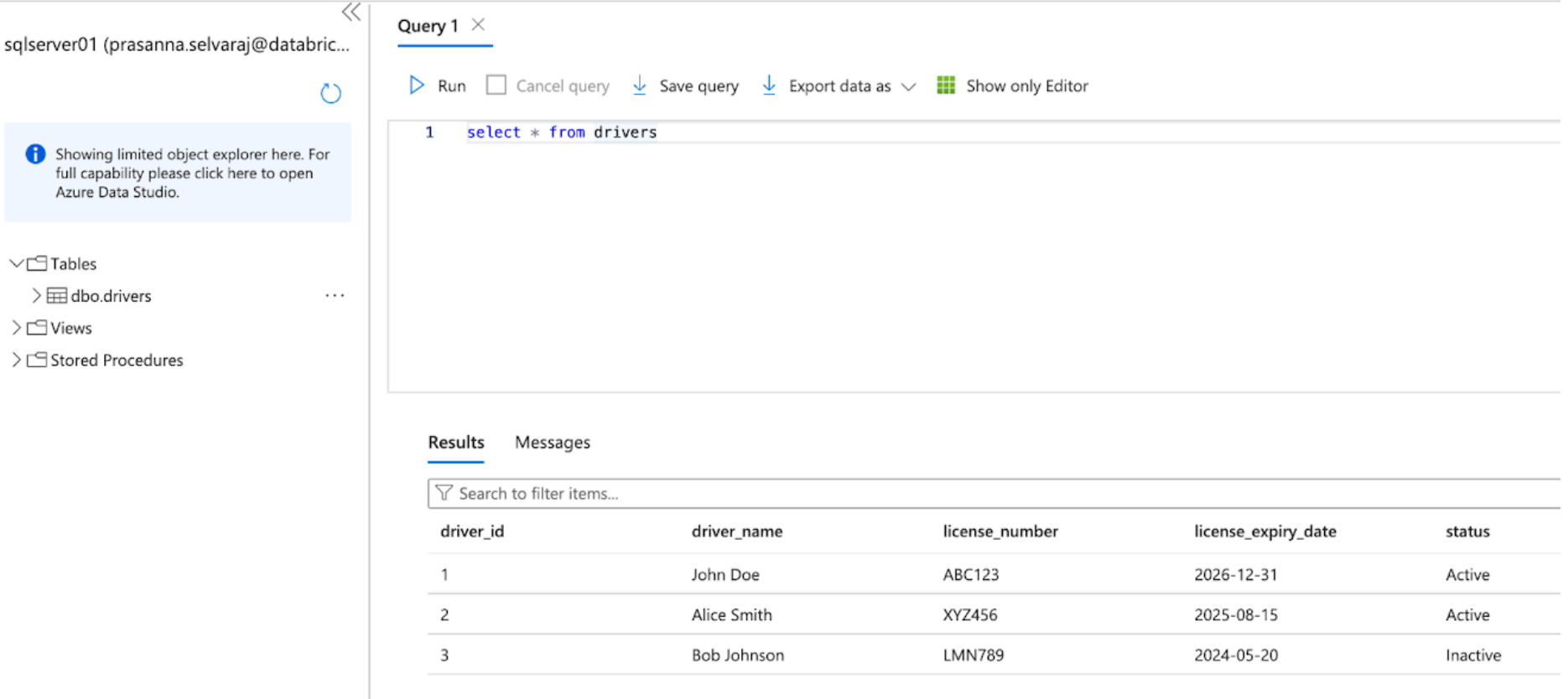
Earlier than replicating the info to Databricks, both change knowledge seize, change monitoring, or each should be enabled.
For this instance, the next script is run on the database to allow CT:
This command permits change monitoring for the database with the next parameters:
- CHANGE_RETENTION = 3 DAYS: This worth tracks adjustments for 3 days (72 hours). A full refresh might be required in case your gateway is offline longer than the set time. It’s endorsed that this worth be elevated if extra prolonged outages are anticipated.
- AUTO_CLEANUP = ON: That is the default setting. To keep up efficiency, it robotically removes change monitoring knowledge older than the retention interval.
Then, the next script is run on the database to allow CDC:
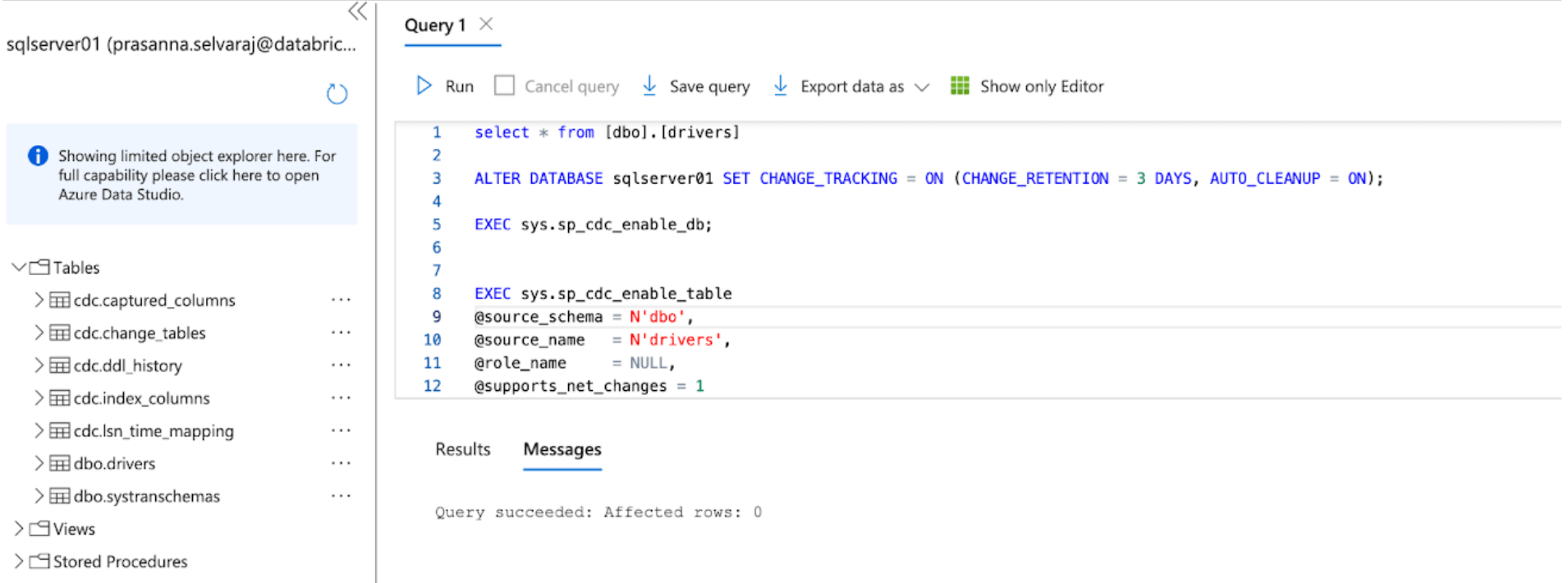
When each scripts end working, evaluation the tables part beneath the SQL Server occasion in Azure and make sure that all CDC and CT tables are created.
2. [Databricks] Configure the SQL Server connector in Lakeflow Join
On this subsequent step, the Databricks UI might be proven to configure the SQL Server connector. Alternatively, Databricks Asset Bundles (DABs), a programmatic technique to handle the Lakeflow Join pipelines as code, can be leveraged. An instance of the complete DABs script is within the appendix under.
As soon as all of the permissions are set, as specified by the Permission Conditions part, you might be able to ingest knowledge. Click on the + New button on the high left, then choose Add or Add knowledge.
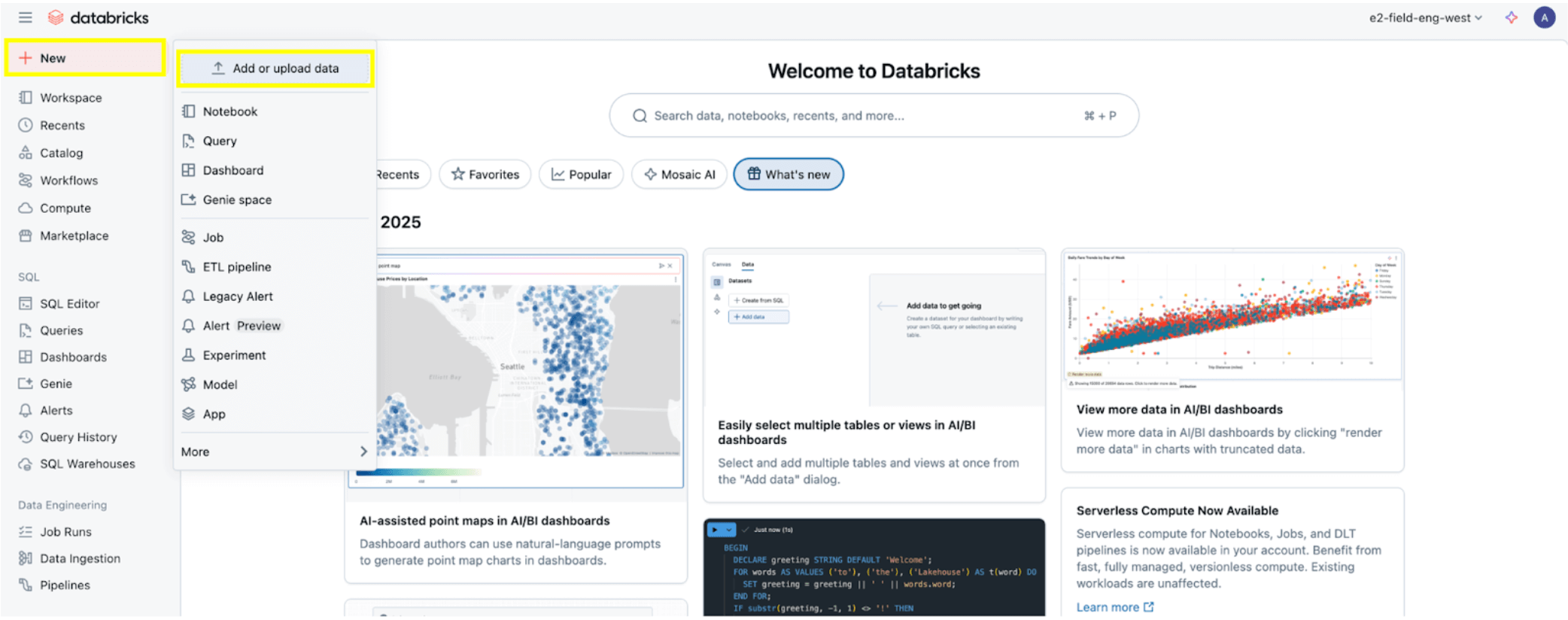
Then choose the SQL Server possibility.
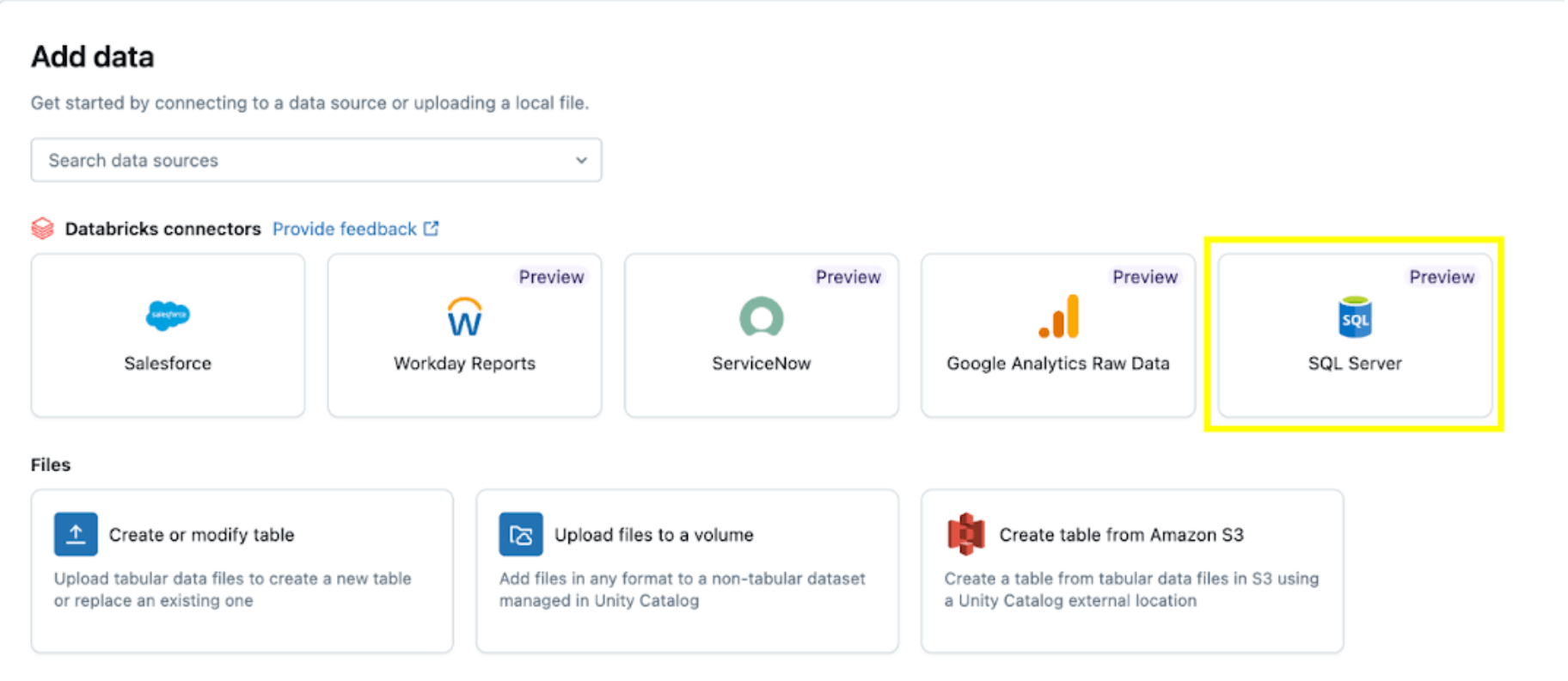
The SQL Server connector is configured in a number of steps.
1. Arrange the ingestion gateway (AWS | Azure | GCP). On this step, present a reputation for the ingestion gateway pipeline and a catalog and schema for the UC Quantity location to extract snapshots and frequently change knowledge from the supply database.
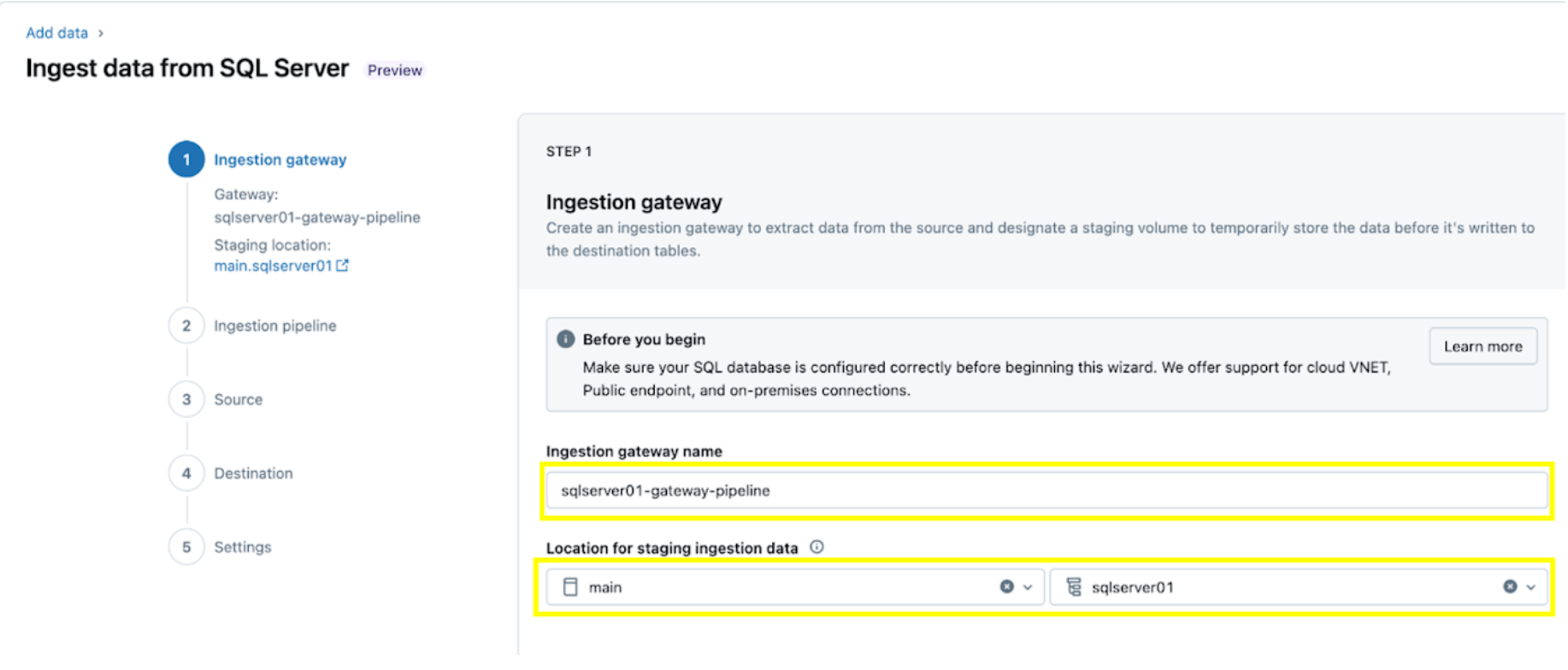
2. Configure the ingestion pipeline. This replicates the CDC/CT knowledge supply and the schema evolution occasions. A SQL Server connection is required, which is created by means of the UI following these steps or with the next SQL code under:
For this instance, title the SQL server connection insurgent as proven.
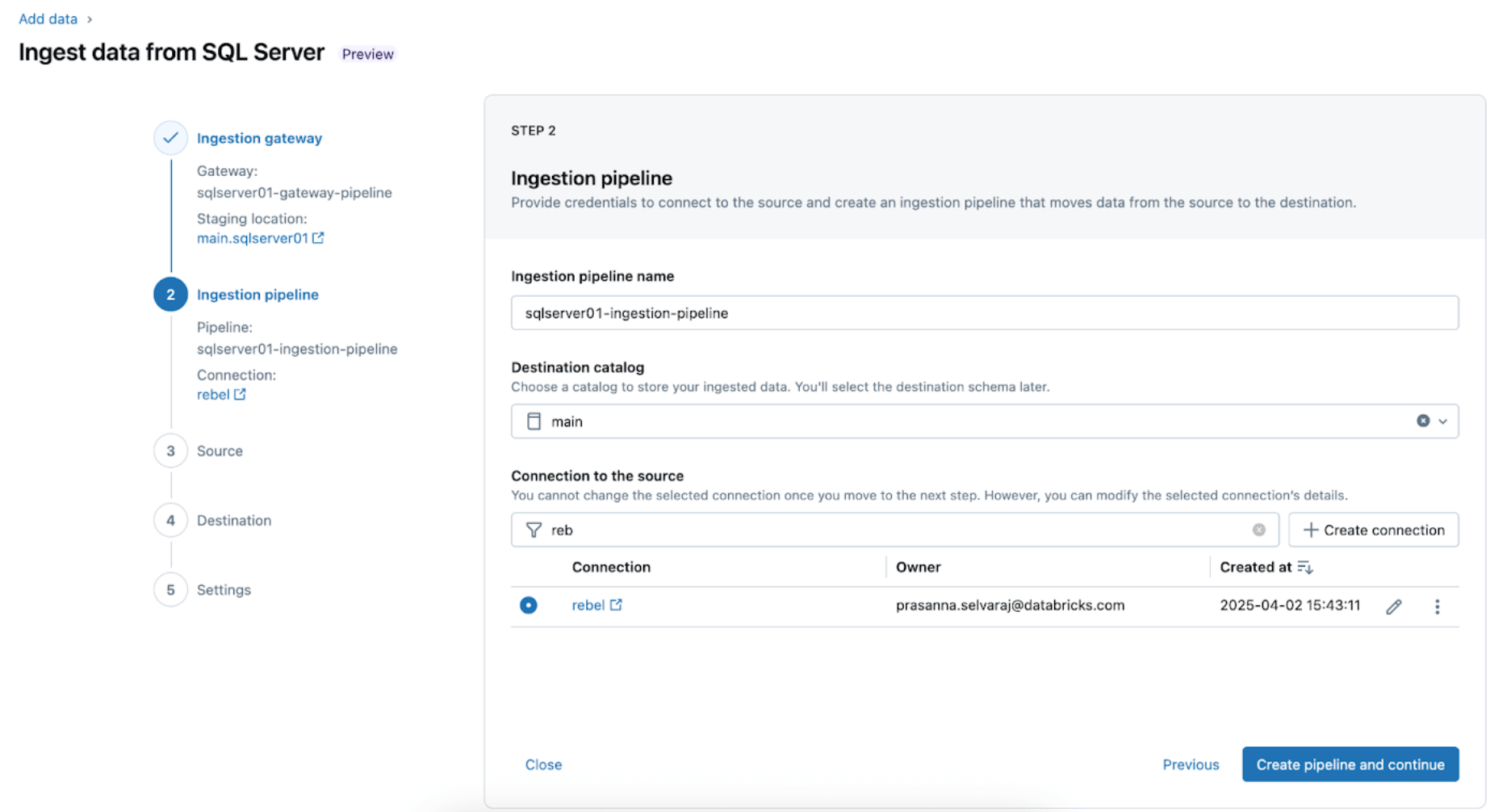
3. Choosing the SQL Server tables for replication. Choose the entire schema to be ingested into Databricks as an alternative of selecting particular person tables to ingest.
The entire schema may be ingested into Databricks throughout preliminary exploration or migrations. If the schema is massive or exceeds the allowed variety of tables per pipeline (see connector limits), Databricks recommends splitting the ingestion throughout a number of pipelines to take care of optimum efficiency. To be used case-specific workflows corresponding to a single ML mannequin, dashboard, or report, it’s typically extra environment friendly to ingest particular person tables tailor-made to that particular want, somewhat than the entire schema.
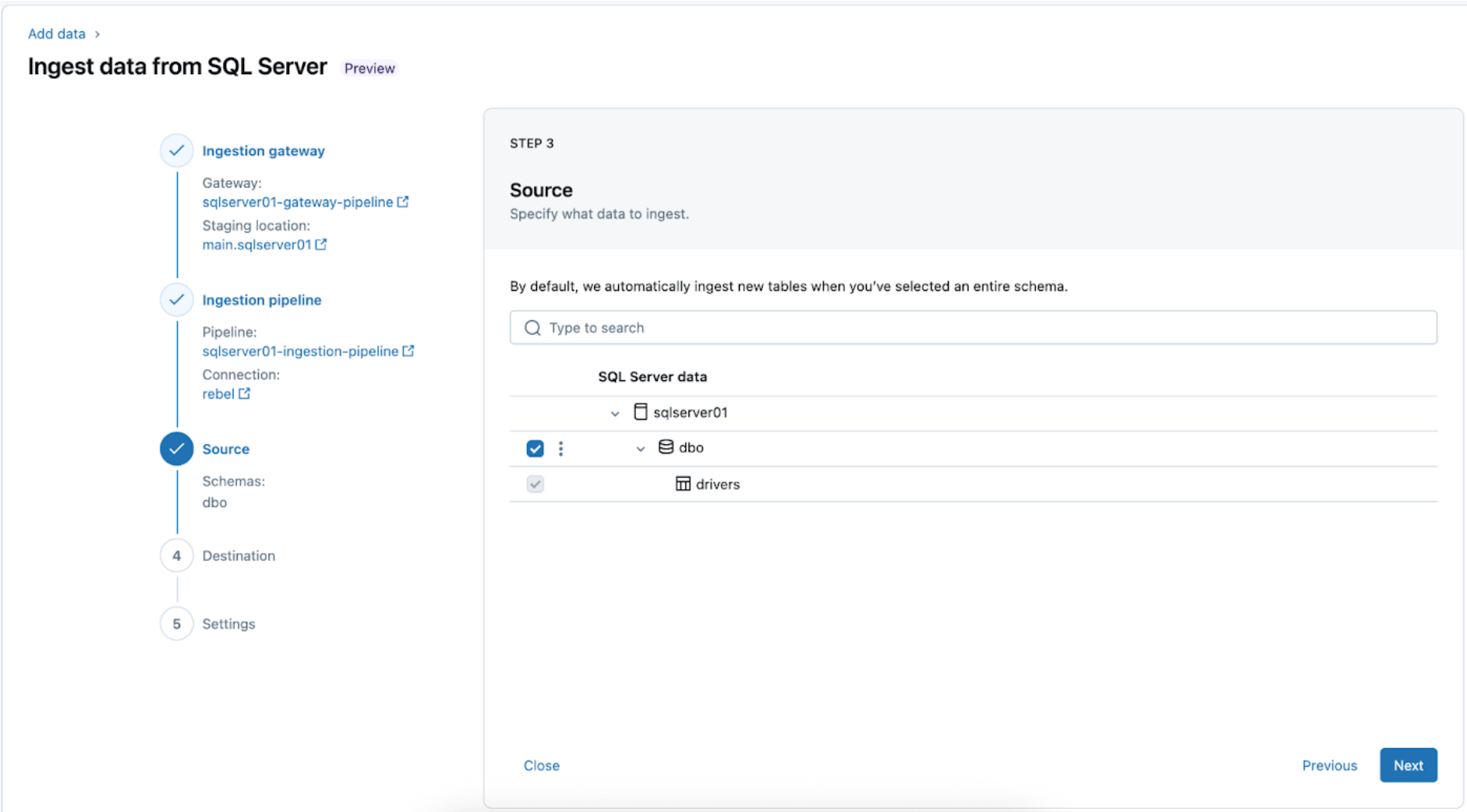
4. Configure the vacation spot the place the SQL Server tables might be replicated inside UC. Choose the principal catalog and sqlserver01 schema to land the info in UC.

5. Configure schedules and notifications (AWS | Azure | GCP). This closing step will assist decide how typically to run the pipeline and the place success or failure messages ought to be despatched. Set the pipeline to run each 6 hours and notify the person solely of pipeline failures. This interval may be configured to satisfy the wants of your workload.
The ingestion pipeline may be triggered on a customized schedule. Lakeflow Join will robotically create a devoted job for every scheduled pipeline set off. The ingestion pipeline is a activity throughout the job. Optionally, extra duties may be added earlier than or after the ingestion activity for any downstream processing.
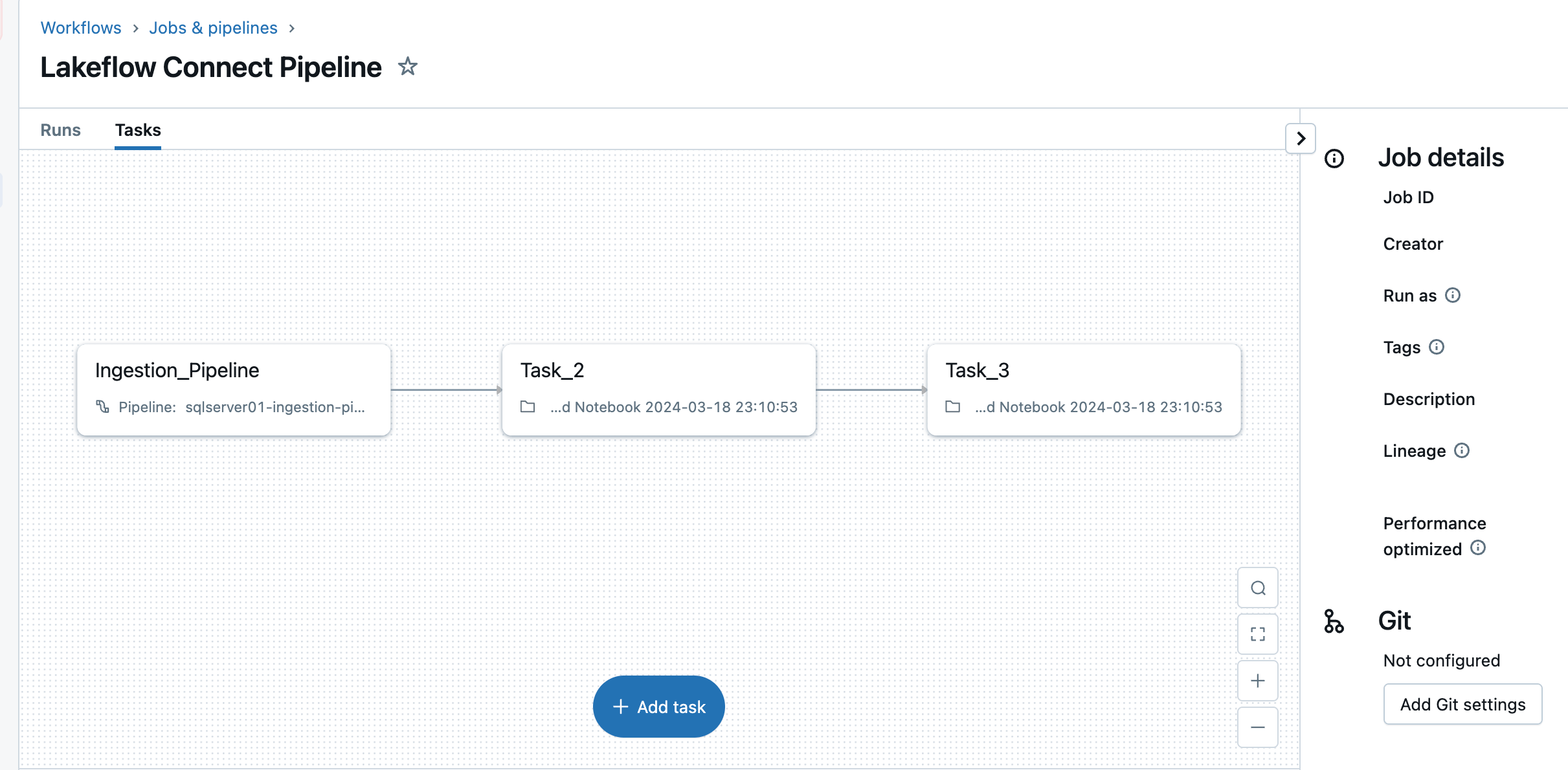
After this step, the ingestion pipeline is saved and triggered, beginning a full knowledge load from the SQL Server into Databricks.
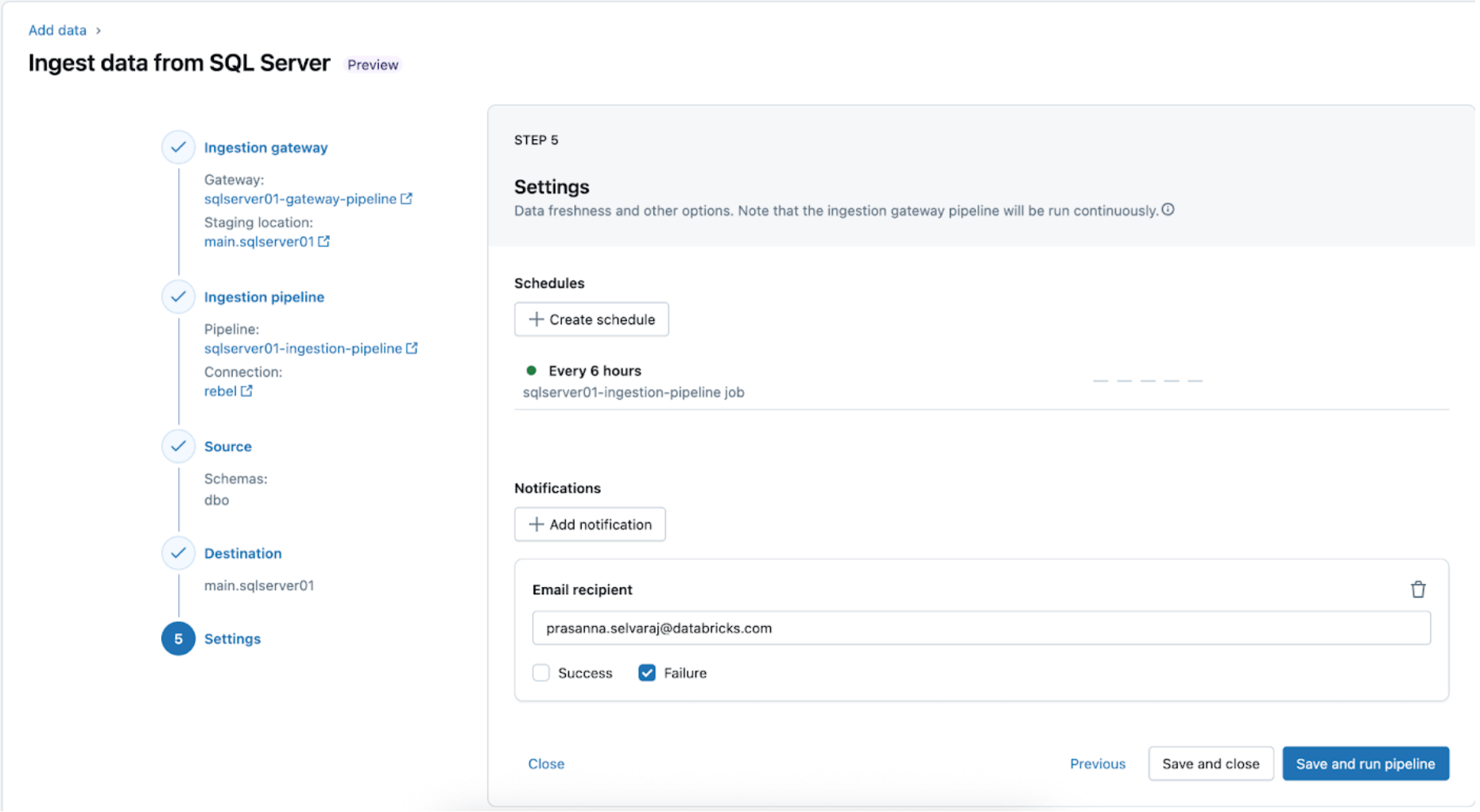
3. [Databricks] Validate Profitable Runs of the Gateway and Ingestion Pipelines
Navigate to the Pipeline menu to verify if the gateway ingestion pipeline is working. As soon as full, seek for ‘update_progress’ throughout the pipeline occasion log interface on the backside pane to make sure the gateway efficiently ingests the supply knowledge.
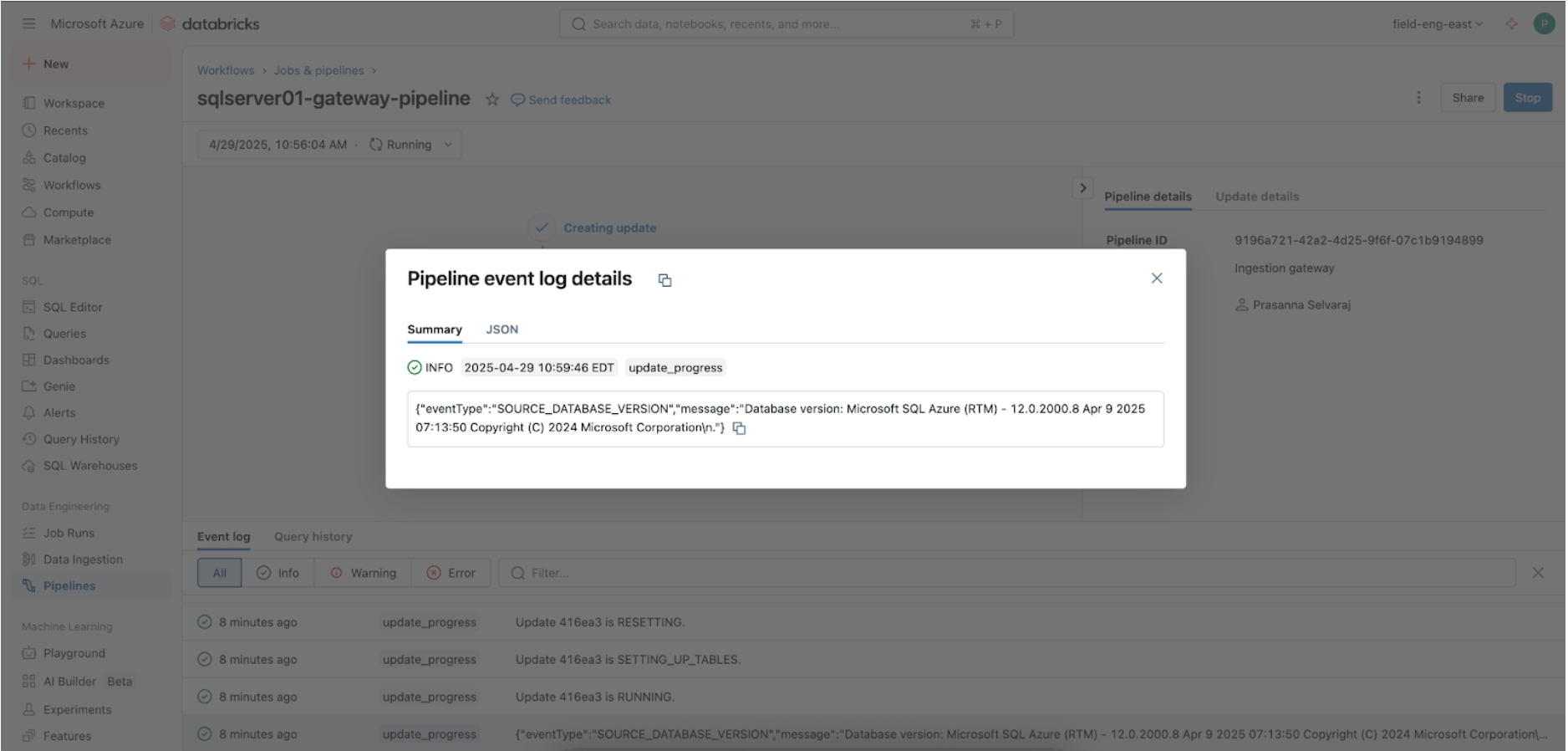
To verify the sync standing, navigate to the pipeline menu. The screenshot under reveals that the ingestion pipeline has carried out three insert and replace (UPSERT) operations.
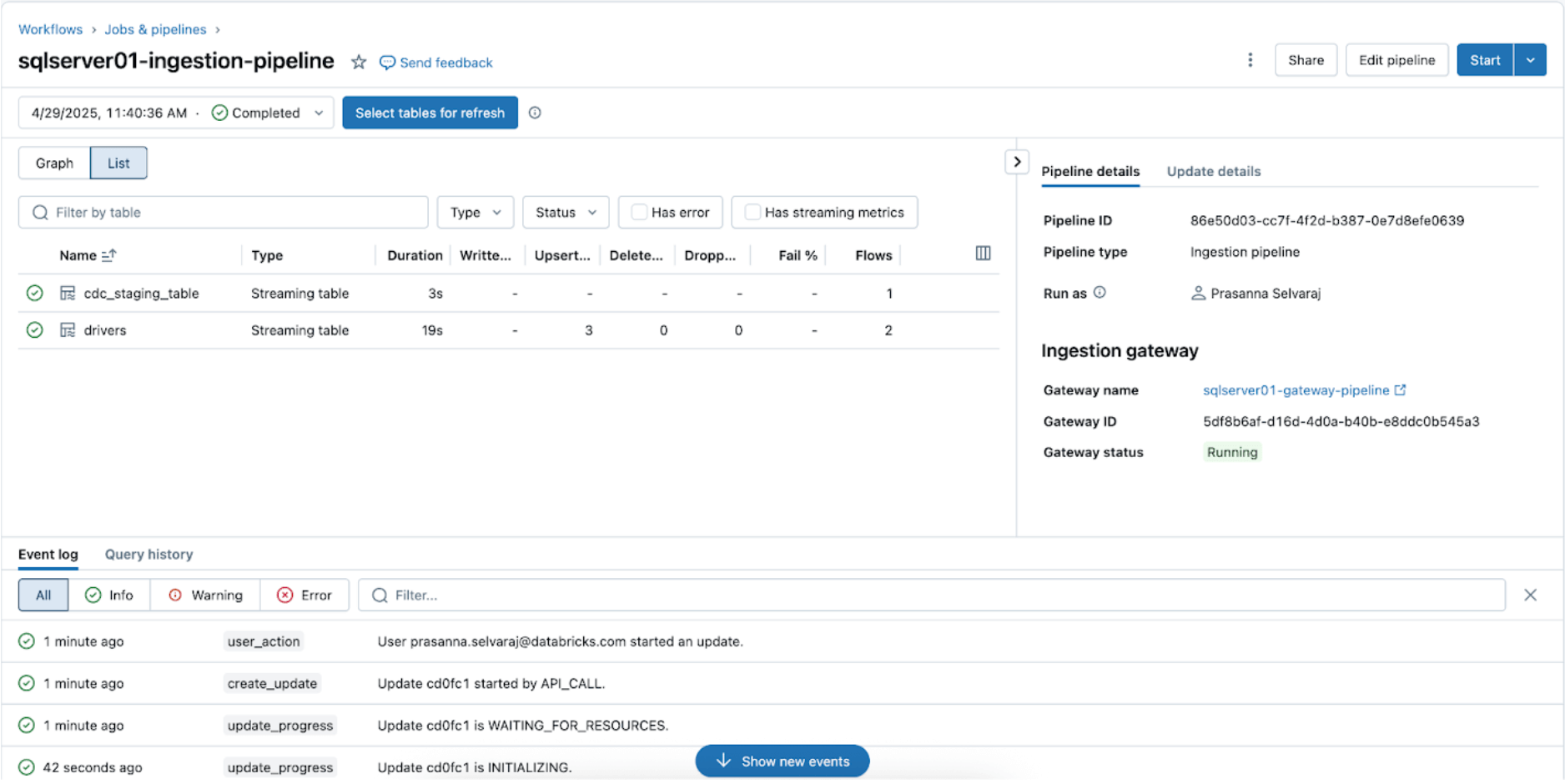
Navigate to the goal catalog, principal, and schema, sqlserver01, to view the replicated desk, as proven under.

4. [Databricks] Check CDC and Schema Evolution
Subsequent, confirm a CDC occasion by performing insert, replace, and delete operations within the supply desk. The screenshot of the Azure SQL Server under depicts the three occasions.
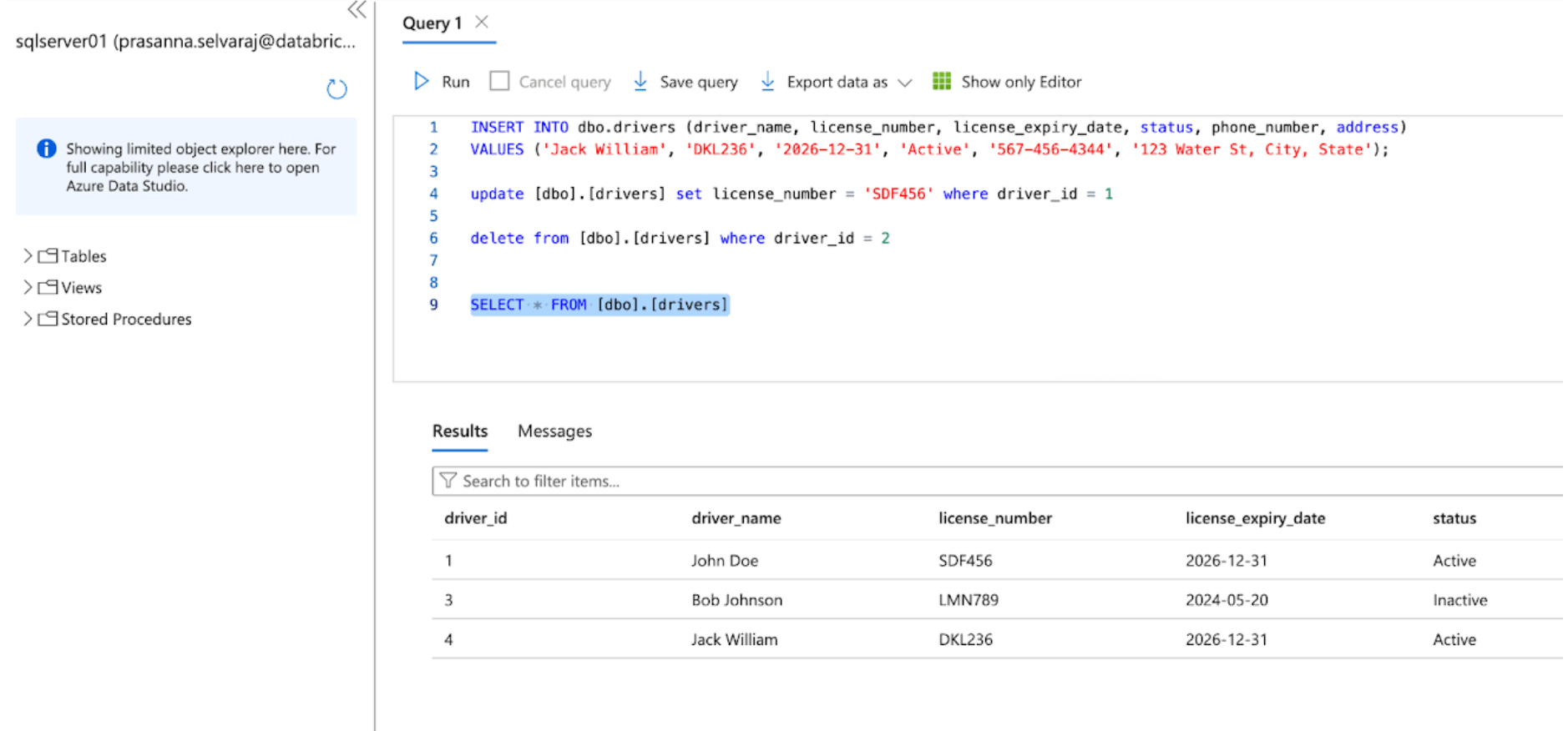
As soon as the pipeline is triggered and is accomplished, question the delta desk beneath the goal schema and confirm the adjustments.

Equally, let’s carry out a schema evolution occasion and add a column to the SQL Server supply desk, as proven under
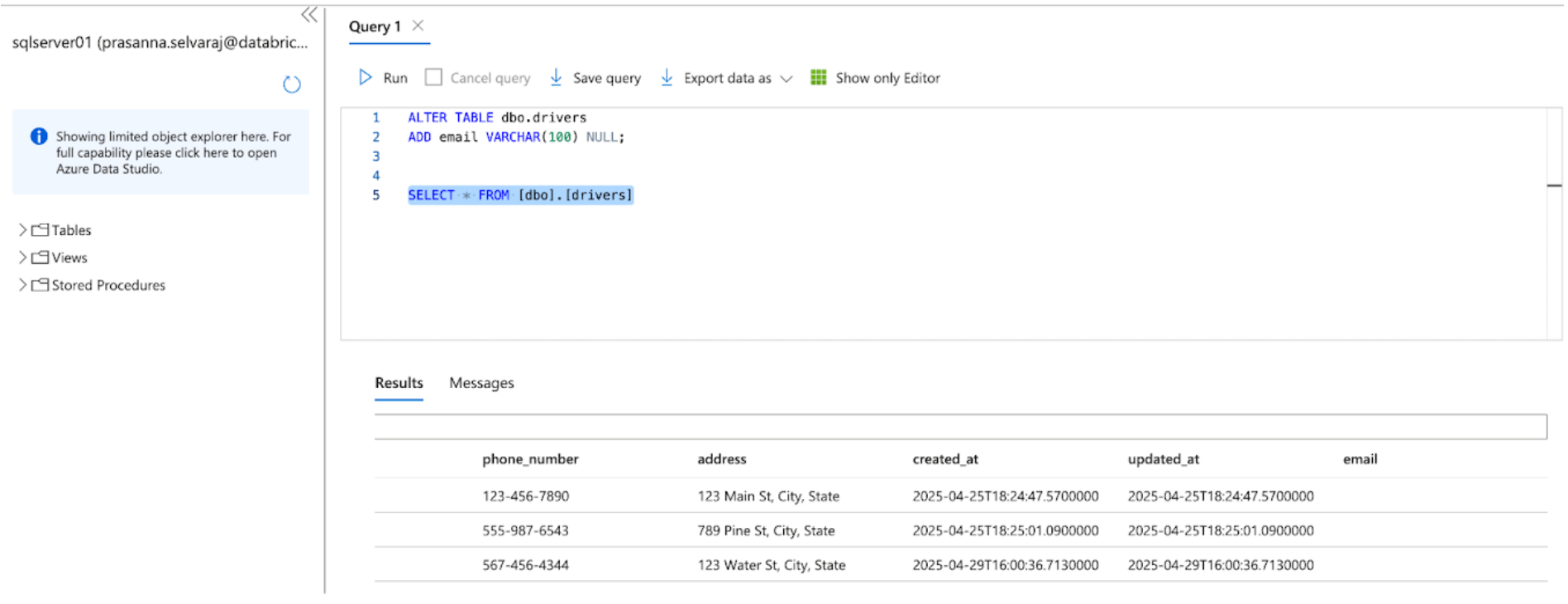
After altering the sources, set off the ingestion pipeline by clicking the beginning button throughout the Databricks DLT UI. As soon as the pipeline has been accomplished, confirm the adjustments by searching the goal desk, as proven under. The brand new column e-mail might be appended to the top of the drivers desk.
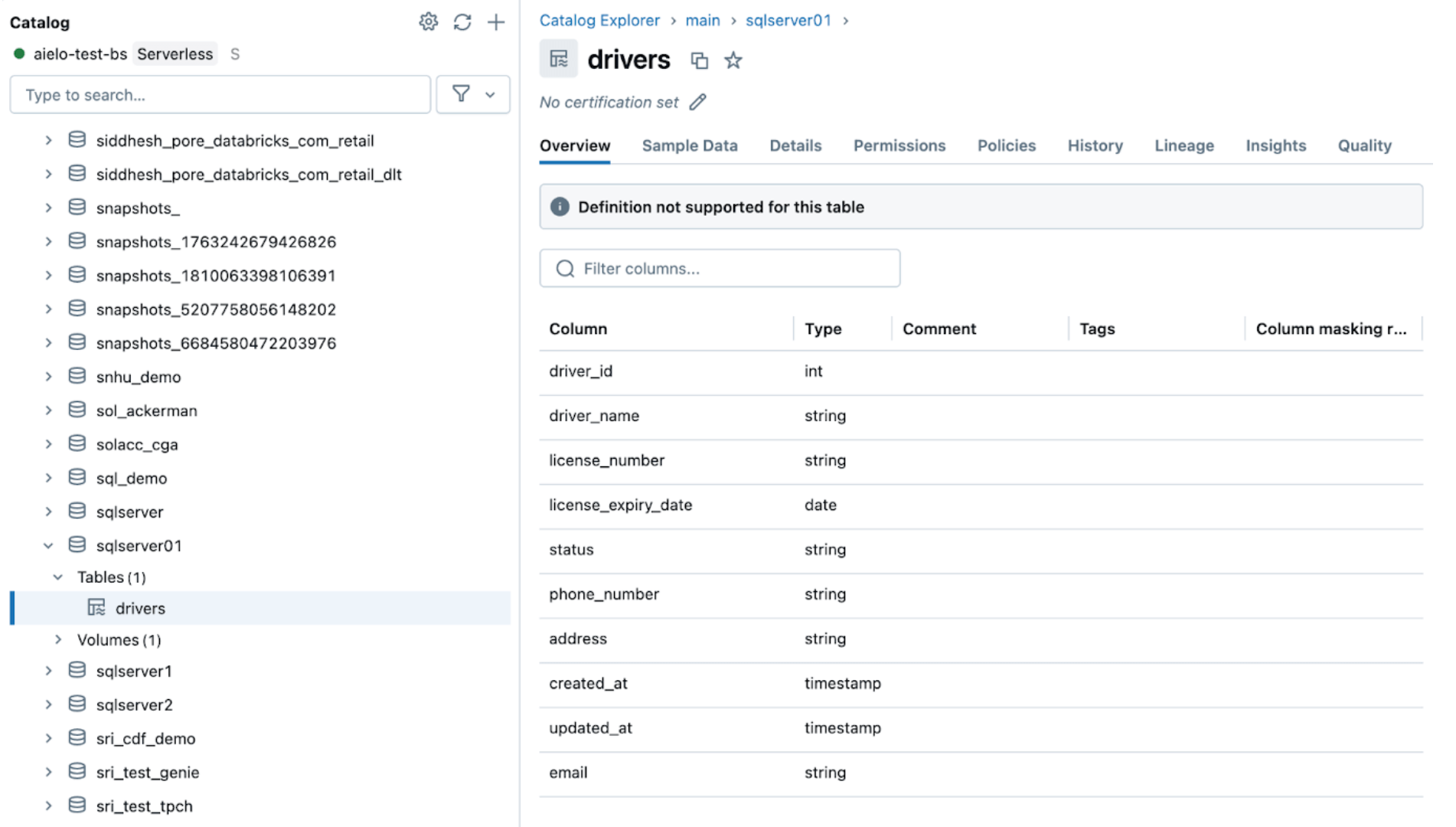
5. [Databricks] Steady Pipeline Monitoring
Monitoring their well being and habits is essential as soon as the ingestion and gateway pipelines are efficiently working. The pipeline UI offers knowledge high quality checks, pipeline progress, and knowledge lineage data. To view the occasion log entries within the pipeline UI, find the underside pane beneath the pipeline DAG, as proven under.
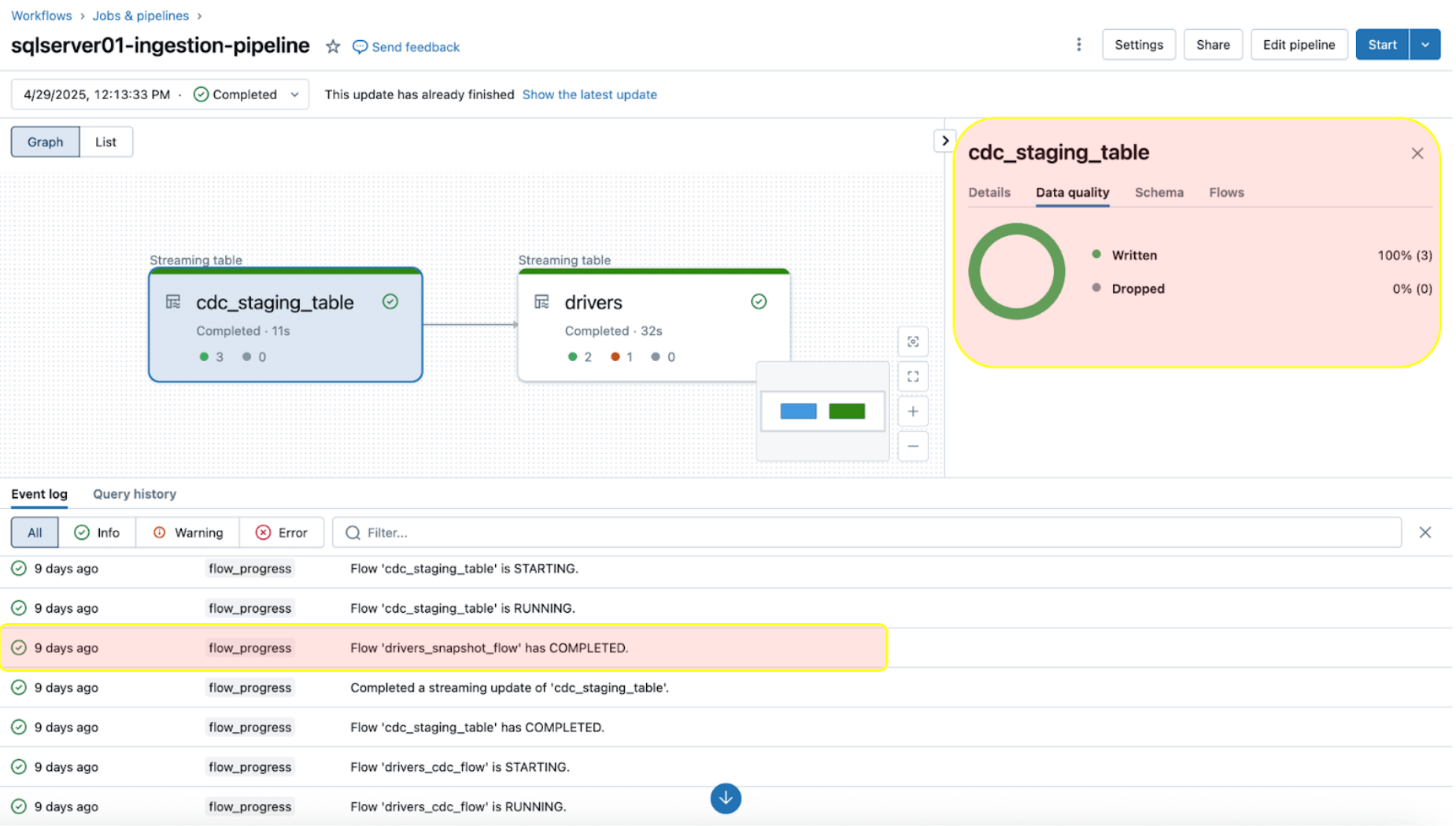
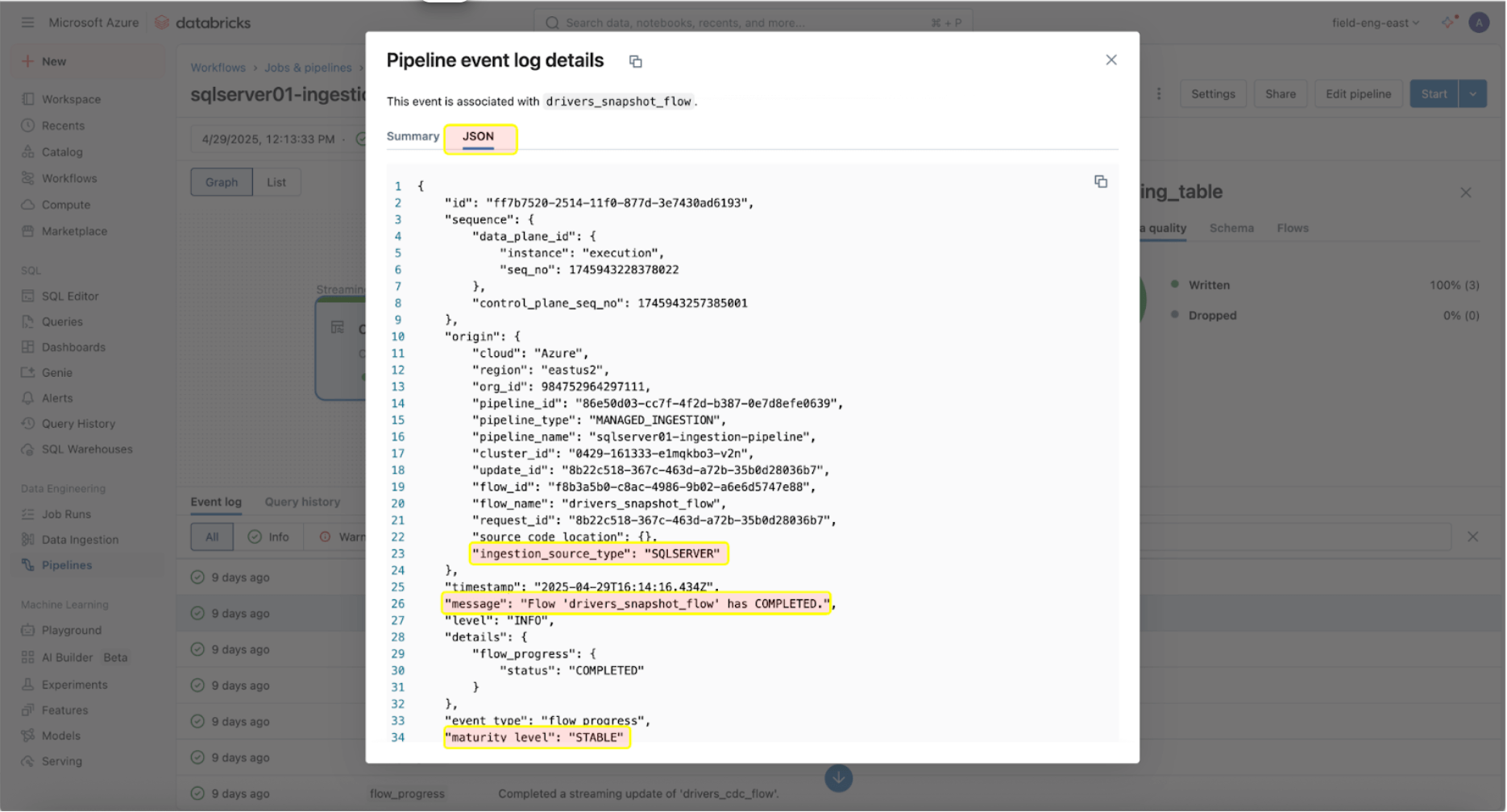
The occasion log entry above reveals that the ‘drives_snapshot_flow’ was ingested from the SQL Server and accomplished. The maturity stage of STABLE signifies that the schema is secure and has not modified. Extra data on the occasion log schema may be discovered right here.
Actual-World Instance
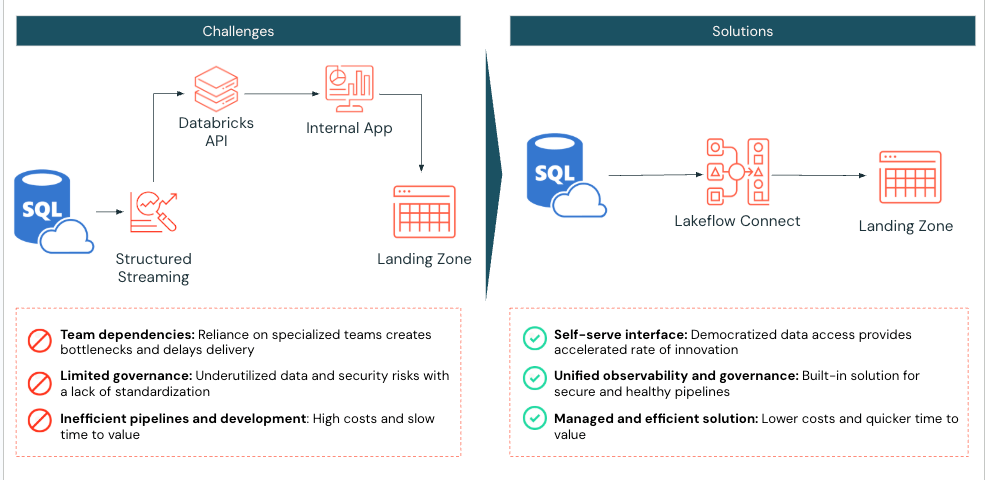
A big-scale medical diagnostic lab utilizing Databricks confronted challenges effectively ingesting SQL Server knowledge into its lakehouse. Earlier than implementing Lakeflow Join, the lab used Databricks Spark notebooks to tug two tables from Azure SQL Server into Databricks. Their software would then work together with the Databricks API to handle compute and job execution.
The medical diagnostic lab applied Lakeflow Join for SQL Server, recognizing that this course of may very well be simplified. As soon as enabled, the implementation was accomplished in simply at some point, permitting the medical diagnostic lab to leverage Databricks’ built-in instruments for observability with day by day incremental ingestion refreshes.
Operational Concerns
As soon as the SQL Server connector has efficiently established a connection to your Azure SQL Database, the subsequent step is to effectively schedule your knowledge pipelines to optimize efficiency and useful resource utilization. As well as, it is important to observe finest practices for programmatic pipeline configuration to make sure scalability and consistency throughout environments.
Pipeline Orchestration
There is no such thing as a restrict on how typically the ingestion pipeline may be scheduled to run. Nonetheless, to reduce prices and guarantee consistency in pipeline executions with out overlap, Databricks recommends at the least a 5-minute interval between ingestion executions. This enables new knowl
Support authors and subscribe to content
This is premium stuff. Subscribe to read the entire article.












